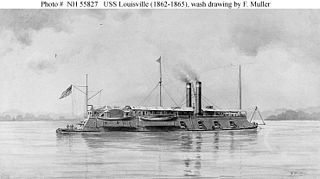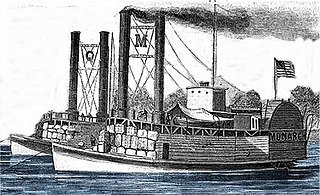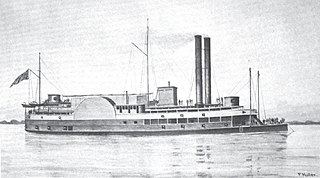
USS Tyler was originally a merchant ship named A. O. Tyler, a commercial side-wheel steamboat with twin stacks and covered paddles positioned aft. Constructed in Cincinnati, Ohio in 1857, it was acquired by the United States Navy, 5 June 1861 for service in the American Civil War and converted into the gunboat USS Tyler on 5 June 1861. She was commissioned in September 1861. She was protected with thick wooden bulwarks.

The third USS Lexington was a timberclad gunboat in the United States Navy during the American Civil War.

The first USS Lafayette was a side wheel steamer, converted to an ironclad ram, in the United States Navy during the American Civil War.

USS Louisville was a City-class ironclad gunboat constructed for the U.S. Army by James B. Eads during the American Civil War.

The first USS Marmora was a stern wheel paddle steamer in the United States Navy.

USS Black Hawk (1848) was a large steamer purchased by the Union Navy during the American Civil War.

USS Monarch was a United States Army sidewheel ram that saw service in the American Civil War as part of the United States Ram Fleet and the Mississippi Marine Brigade. She operated on the Mississippi River and Yazoo River during 1862 and 1863.
The second USS Petrel was a tinclad wooden steamer in the United States Navy. Petrel was purchased as Duchess at Cincinnati, Ohio, 22 December 1862, renamed Petrel, and commissioned with Volunteer Lt. John Pearce in command.

The City-class ironclad USS Cincinnati was a stern-wheel casemate gunboat in the United States Navy during the American Civil War. She was named for Cincinnati, Ohio, and was the first ship to bear that name in the United States Navy.

USS Signal (1862) — a small 190-ton steamship — was acquired during the second year of the American Civil War by the Union Navy and outfitted as a gunboat. She also served other types of duty, such as that of dispatch vessel and convoy escort.
USS Curlew (1862) was a Union Navy steamship purchased during the second year of the American Civil War.

USS Fort Hindman (1862) was a steamer acquired by the Union Navy during the American Civil War. She was placed in service and used by the Navy to patrol navigable waterways of the Confederacy to prevent the South from trading with other countries.
USS Ivy (1862) was a steamer acquired by the Union Navy during the American Civil War.

USS Ouachita (1863) was a steamer captured by the Union Navy during the American Civil War. She was used by the Navy to patrol navigable waterways of the Confederacy to prevent the South from trading with other countries.

USS Cricket (1862) was a steamer acquired by the Union Navy during the American Civil War.
USS Springfield (1862) was a steamship purchased by the Union Navy during the American Civil War. She was used by the Union Navy as a gunboat assigned to patrol Confederate waterways.
USS Juliet (1862) was a steamer acquired by the Union Navy during the American Civil War. She was used by the Union Navy as a gunboat in support of the Union Navy blockade of Confederate waterways.
The first USS Silver Cloud was a steamer acquired by the Union Navy during the American Civil War.
USS New Era (1862) was a steamer acquired by the Union Navy during the American Civil War. She was used by the Union Navy as a gunboat in support of the Union Navy blockade of Confederate waterways. New Era was also a name initially carried by a timbercladUSS Essex.

The Yazoo Pass expedition was a joint operation of Major General Ulysses S. Grant's Army of the Tennessee and Rear Admiral David D. Porter's Mississippi River Squadron in the Vicksburg campaign of the American Civil War. Grant's objective was to get his troops into a flanking position against the Rebel defenders. The expedition was an effort to bypass the Confederate defenses on the bluffs near the city by using the backwaters of the Mississippi Delta as a route from the Mississippi River to the Yazoo River. Once on the Yazoo, the Army would be able to cross the river unopposed and thus achieve their goal. The operation would require a deep penetration into enemy territory that was dominated by water, so cooperation between the two services was necessary. The Army was led by Brigadier General Leonard F. Ross. Naval commander was Lieutenant Commander Watson Smith, who was in extremely poor health; his health was an important factor in the ultimate failure of the expedition.














